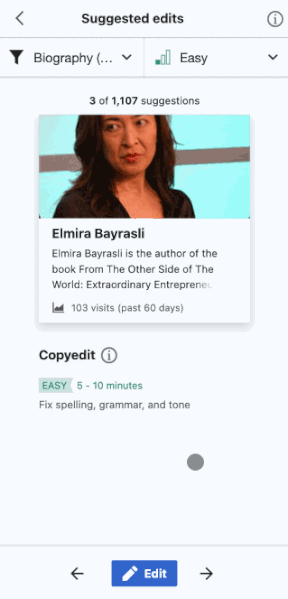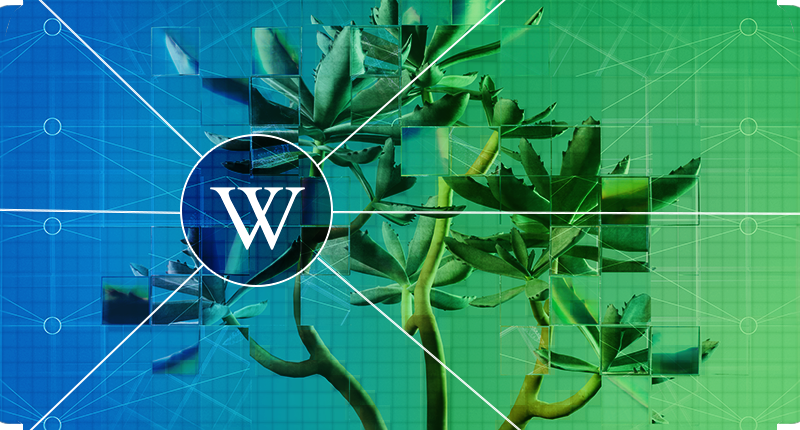New features on Wikipedia are making it easy for everyone to edit Wikipedia, especially those contributing to the site for the first time.
Every time you read a Wikipedia article, you are reading the work of a volunteer contributor.
Nearly 300,000 people from around the world edit Wikipedia articles each month — they start new pages, fix typos, add images and references, and more. They curate and create the knowledge available on the world’s largest online encyclopedia. It is a massive undertaking and responsibility.
Many Wikipedia editors have been contributing for years, including several who have been around since the site was started 21 years ago. Their familiarity and expertise in applying Wikipedia’s practices and guidelines are essential in more ways than we can count. But equally essential to our shared mission of becoming the sum of all knowledge is adding new contributors to our projects. New contributors from all over the world bring diverse perspectives and knowledge that will carry Wikipedia forward, making sure that Wikipedia’s content represents the full and rich diversity of all humanity.
Over the last four years, the Product Department at the Wikimedia Foundation has been building new ways for people to get into editing Wikipedia for the first time.
Recently, the team rolled out its newest set of features to support “newcomers” (new Wikipedia editors). These features include a newcomer homepage as a dashboard for new editors, a mentor program in which experienced volunteers guide new ones on editing, and a feed of suggested edits that uses machine learning to offer quick and easy first edits. The features were developed in close collaboration with existing Wikipedia volunteers and communities.
To learn more, we talked with Marshall Miller, the Wikimedia Foundation Group Product Manager who worked with the team that developed these new features, and Rita Ho, the Principal Designer who designed them.


Q: What inspired your team to work on this project, and why now?
Rita: We know from data and user research that editing Wikipedia is less popular than it used to be. Many people are too intimidated to edit because they think they don’t have the time, technical expertise, or specialized knowledge to make a contribution. Additionally, new folks are sometimes put off either because they’ve had a negative experience with experienced members of the editing community, or else feel alone due to a perceived lack of community. To advance knowledge equity, we need to encourage people from all walks of life to contribute, no matter how big or small their edits may be.
Marshall: Over the years, the Wikimedia movement has done amazing things to help people learn to edit, from holding events, written documentation, and instructional videos and tools. The Foundation wanted to support this by making a difference in the Wikipedia user experience itself. If we want more kinds of people to edit Wikipedia, we need more kinds of ways to edit Wikipedia.
Q: How would you describe these features to someone new to Wikipedia?
Rita: Previously, the experience for many new editors on Wikipedia was confusing and inaccessible. As a result, many of those people either never edited at all, or edited once and never returned. Our approach to encouraging a more diverse, thriving editor movement is led by these new features. The first two are the “newcomer homepage” and “suggested edits,” described below.
Newcomer Homepage
Some of the main challenges expressed by new editors include technical ones, such as learning the editing tools, and more conceptual challenges, like learning the rules, policies, and what appropriate content on Wikipedia looks like. Another challenge for many newcomers was understanding the cultural aspects behind editing on Wikipedia. For example, when you edit and add something to Wikipedia, other volunteers will validate or cross-check this content for approval. Actions like those can cause discussions or debates for people who don’t understand how the process works.
To respond to these challenges, we implemented a homepage that greets each new editor when they first join Wikipedia. This is meant to be a clear starting point on where and how to begin editing. On the homepage, new editors will find several features to make the process easier, including an assigned mentor, who is an experienced Wikipedian that they can go to for any questions or guidance; and an impact module that shows how many times articles they edit have been viewed – showing in real-time that their edits are viewed by the world.

Suggested Edits
Assisted by machine learning, the suggested edits feature introduces new ways to edit so that people with all different interests and skills can get started with editing. We ask newcomers questions about their interests when they first join; the feature then offers tasks related to those interests. Then, newcomers are walked through each step of a simple first task, such as adding a link or image to an article.
These features are all mobile-friendly, making it easy and accessible for many to start editing from their phones—the way the majority of people access the internet today.

Q: How did Wikipedia volunteers collaborate in the development and implementation of these new features?
Marshall: Our team has a philosophy of building new products and features with Wikipedia volunteer communities, not just for them. Volunteers have the best understanding of how their wikis work and what solutions will best improve Wikipedia.
We work with community ambassadors and volunteers who speak multiple languages and have a deep understanding of their communities’ needs. These collaborators bring their communities into the product-development process and create strong communication channels.
Rather than just releasing these changes without warning, we share the decision-making process with volunteer communities, and we give community members some control over how these features function on their specific language version of Wikipedia. For example, the Portuguese Wikipedia might have different homepage features than the Spanish Wikipedia, which they choose according to their community’s needs.
Q: What have been the results of these new editor features so far?
Marshall: Through controlled experiments and conversations with volunteer communities, we’ve seen that this new experience has statistically improved newcomer engagement and editing on Wikipedia.
With all the current features in play, we see a 16 percent improvement in the likelihood that newcomers make the first edit and that they return to continue making edits. Since 2019, when we first started piloting the features, about 700,000 article edits have been made with help of these features by 85,000 people, and about 80,000 questions have been asked to mentors.
Although numbers tell their own story, I think hearing a community perspective can offer a more complete picture of the impact of these features. Ankan Ghosh Dastider, one of our community ambassadors from Bengali Wikipedia, told me:
“Bengali Wikipedia still lacks qualitative content on a variety of topics, and the main reason is the low number of contributors compared with other large Wikipedias. After all, contributing to Wikipedia projects can seem difficult at first for newcomers – they have to use words that are neutral, support the added information with proper references, and follow the policies that are often difficult to understand from their perspective.
I am thankful for these new editor features, as they have had a positive impact on my community and Wikipedia so far. The mentor’s platform, in particular, has had a big impact on supporting new contributors. The Bangla Wikipedia volunteer community has good faith in these updates and we are looking forward to a deeper and more effective involvement of newcomers in the future days with the introduction of even more features.”
Q: So, how can we check out these features ourselves and get involved?
Rita: That’s the easy part: just create an account in any language Wikipedia and get started.



